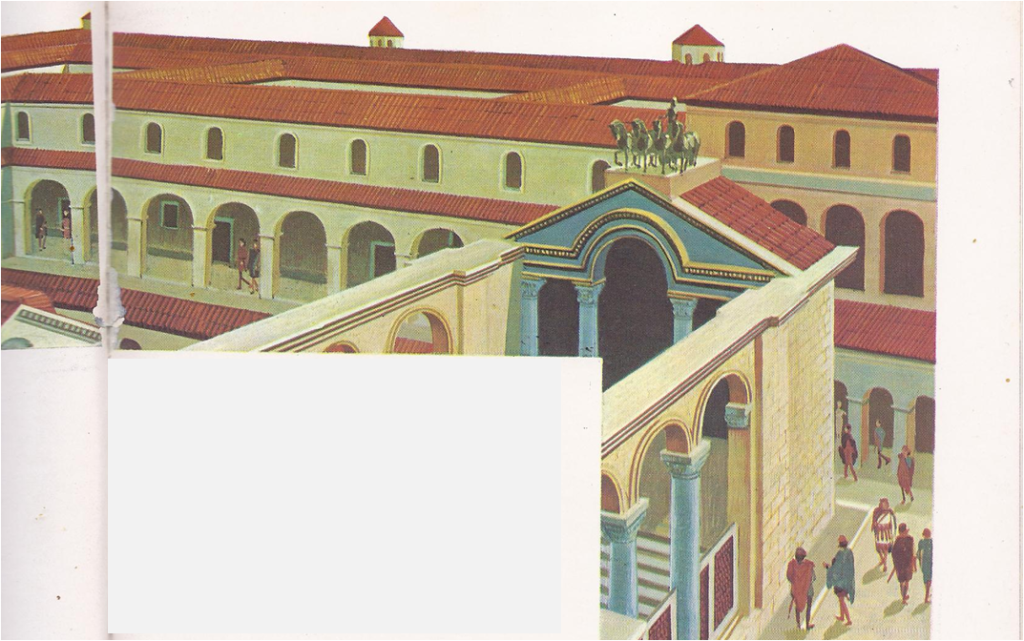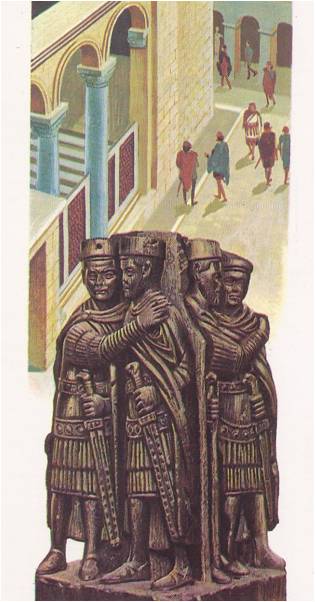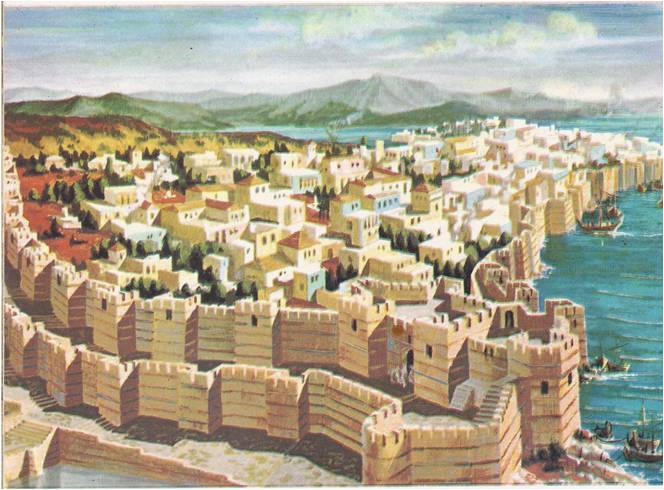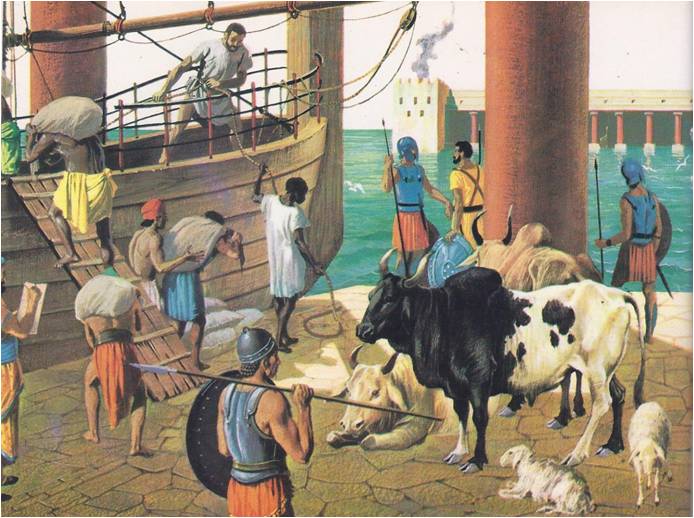ON ROME’S first day, Romulus took a bronze plow and drew a magic circle around seven of the hills that stood beside the River Tiber. The magic of the circle was protection against the evils outside. More important, it bound together the people who were inside, making one city where there had been six towns.
Seven hundred years later, Augustus drew another magic circle, this time around all the Mediterranean world. It kept out barbarian and Asian invaders and held together millions of people, making one empire where there had been dozens of races and nations. So long as the circle had its magic power, Rome would exist.
There was no magic in the circles themselves. The real magic had been in Romulus himself, a chief who was strong and wise enough to build a city. There had been magic, too, in Augustus, whose wisdom had brought order and peace to an empire. Without such men, the circles were powerless. Invaders and conquerors could break through them. The people and countries they held together would fall apart. That was what happened to Rome after the death of Marcus Aurelius.

TOO MANY CAESARS
It did not happen all at once. There was still an empire and there were emperors who tried to rule it — too many, in fact. When Commodus was murdered, four would-be rulers, each with a Roman army behind him, fought over the throne. The winner, Septimus Severus, the commander of the Danube troops, held it for eighteen years. When he was about to die, he gave his two sons a piece of advice about ruling Rome: “Stick together, pay the soldiers and forget the rest.”
His sons did not stick together. When Septimus was dead, each of them tried to be the emperor. Caracalla, the elder of the two, settled the dispute by murdering his brother. Then he remembered his father’s words and set out to grab as much money as he could for his soldiers and, of course, for himself. Years later, he was remembered as the emperor who had the wisdom and generosity to grant the rights of Roman citizenship to all the freemen of the empire. It was an important step in the development of Rome, but at the time, many people said it was only Caracalla’s way to add to the number of Romans who paid taxes to him. If he meant it as an act of generosity, it was his first and last. Afterwards, he gave the citizens of Rome five years of the kind of rule that had made Nero and Caligula famous. The captain of the Praetorian Guard again saw his duty and Caracalla was murdered. Then the armies took over the business of picking a new emperor.

Some of these soldier-emperors scarcely had time to sit down on the throne before they were pushed off again by a rival or by their own mutinous troops. In seventy years, more than seventy-five men claimed the title Augustus and the imperial power that went with it. In one year alone, six emperors were proclaimed, enthroned and murdered by their troops.
The circle that held the empire was splintered. Civil wars destroyed all order inside it. Government in the capital was a muddle of confused clerks and officials who did not know from one day to the next which emperor they were working for. When the treasury ran out of money, copper coins had to be made instead of silver ones. That sent prices up until people could no longer afford to pay them. Then business stopped; citizens and government alike faced ruin.
TROUBLE IN THE PROVINCES
In the provinces, it was even worse. Laws were openly disobeyed. Robbery and murder went unpunished. Along the splendid Roman roads, bands of thieves preyed on travelers and the merchants’ caravans.
When the legions left the frontiers to fight in the battles for the throne‚ wave after wave of barbaric invaders rushed through the weak spots along the borders. In Britain‚ Hadrian’s wall was pierced, then overwhelmed. Raiders from the Asian kingdoms made frequent attacks along the eastern frontier, weakening defenses that were already crumbling. There was no power in Augustus’ circle now. When the city of Rome began to build a fortified wall for its own defense, fear and unrest in the provinces turned into panic.
In Syria, the beautiful, dark-haired Queen Zenobia of Palmyra set up an independent kingdom of her own. Proclaiming herself the descendant of Cleopatra, she led a revolt against the empire. All of Egypt and half of Asia Minor went with her and it was three years before the legionaries arrived to disperse her troops. Then Palmyra was burned to the ground and Zenobia, bound in chains of gold, was led away to Rome. But her defiance had set an example and other revolts sprang up as local leaders realized that they no longer looked to Rome for protection. No longer could they count on the power of the emperor. Often they could not be sure who he was.
Fear and poverty haunted the cities. Trade fell off and farmers began to leave their fields unplanted. The plague broke out again; for fifteen years it raged across the empire. Earthquakes destroyed many of the Asian towns. Still the parade of emperors and would-be emperors went on in Rome.
DIOCLETIAN RESTORES ORDER
Then, in A. D. 284, it stopped. A general named Diocletian, who seemed no different from all the others, refused to be pushed aside. The Romans were startled, for Diocletian was no one’s favorite among the four generals who had their eyes on the throne that year. He overcame all of his rivals and the Romans looked him over again. Could he succeed where so many others had failed? With a keen mind and an iron fist, Diocletian held his throne for twenty years. In that time, he ran his own circle of power around the empire and gave it the strength to last for eighty years more. Too many Romans, however, it seemed more like a prison wall. Diocletian’s soldiers were posted everywhere, not just on the frontiers. Bakers and food merchants had to feed them without being paid for it. Ship-owners transported them for nothing. Taxes went higher and higher and the emperor made the rich men in town responsible for collecting them. They could get the money or grain from their neighbors, or pay all of it themselves, or go to prison. Before long, the Romans discovered that making money was not worth while, because they got to keep so little of it. When they tried to close their businesses or to give up their farms, Diocletian passed a law that forbade them to do it. Their sons, too, were forced by law to keep the family businesses going. Soldiers’ sons had no choice but to go into the army. Farm workers were not allowed to move to another farm, much less to another sort of job. So they went on working, not for themselves but for the empire and the emperor. The price for peace and order was high and the Romans paid it with their freedom as well as with their money.
Yet many citizens did not mind the new system. The empire had taken care of them for so long that they could not imagine what it would be like to take care of themselves. They needed a pater familias in Rome. The idea of losing some of their freedom — even the right to choose their own jobs — did not frighten them nearly as much as the idea of not being looked after. Then there were the millions of freemen who had once been slaves. Slavery had taught them to obey a master and not to complain. Given their freedom, they still took the good or the bad that came their way without complaining and they felt easier when someone told them what to do.
Diocletian was more than ready to give the orders. He made himself pater familias, master, and a god. Though his mother had been slave and he had had to work his way through the rough ranks of the legions, he proclaimed himself a god-king. Dressed in the pearl-encrusted crown and silken robes of an Oriental monarch he commanded the citizens of the empire to call him, Jovius, the child of Jupiter and Dominus, sacred lord. Of course, he was Augustus too.
He was willing to share his power, however. Closing the frontiers to invaders was more work than one commander could do, so he took charge of the eastern borders himself and gave the job of holding the west to his trusted officer, Maximian. He also gave him the name Augustus and all the honors of an emperor.
Two emperors and two empires? Not yet, but when Diocletian made his plan, he drew a line down the center of the Roman world. In a hundred years, that line became a crack. Then it broke open and no emperor or magic could put it together again.
For twenty-one years, Diocletian held the empire in one piece with the strength of his troops and his laws. Then, satisfied with his work and realizing that he was growing old, he resigned and persuaded Maximian to do the same. This was a special kind of triumph, because Diocletian gave up his office and his crown in “the same way that he had won them: by his own will and by his own power. Before he retired, he named the men who were to take over his government. Within two years there were six eager emperors fighting over the throne. When any of them asked Diocletian’s help, he refused to give it. Perhaps he felt as Alexander did when he was asked who should rule his empire after he was gone. Alexander had replied, “It must go to the strongest.”
Diocletian’s empire went at last to Constantine, a man who said he had no strength in himself at all. The power which brought him victory, he said, was the power of his god, the god of the Christians. On the night before his greatest battle, he had seen in the sky a glowing cross and the words, In hoc signo vinces — “By this sign you will conquer.” This, he said, was God’s way of telling him that he had been chosen to rule Rome. He did not have to call himself a god in order to be the emperor and the people did not have to worship him. In obeying him, they also obeyed God, because God had selected him to govern them.
CONSTANTINE THE CHRISTIAN
So now the Christian God, whom so many emperors had feared as a danger to their own power, became the defender of emperors. Many of the Romans, whether they were Christians or not, liked the idea. It had always been hard to believe that a rough soldier was a god just because he had defeated all the other soldiers who wanted to be emperor. It was easier to believe that a soldier had been chosen to rule by a god and had been given the power and wisdom to do it. For the next 1,400 years or more, the kings of Europe would claim their thrones by this same “divine right.”

Although Constantine was a Christian, he did not try to stamp out the other religions in the empire, nor did he pass laws against them. He did decree that there would be two capital cities of Rome — the Italian one of Romulus and Caesar and a new eastern one of his own. In the new city his churches would not be surrounded by old pagan temples.
The place he chose for the new Rome was Byzantium, the ancient Greek stronghold on the Hellespont. The Greek settlers had been told to build there by the Oracle, the priestess who spoke with the wisdom of the gods and it was wise advice. Byzantium stood at the spot where the land route between Asia and the Danube jumps across the channel between the Black Sea and the Mediterranean — truly a crossroads of the world. The hilly little peninsula, bound by water on three sides, was a superb natural fortress and had a line harbour. It was beautiful as well. Constantine shipped his architects and builders to the old town and they went to work.
Four years later, in the year 330, the New Rome was ready. The first visitors were amazed to find a dozen palaces rising on the hills, and churches, triumphal arches, huge Roman baths and a stately arena, the Hippodrome. Wherever the visitors went, along the streets or in the shining new buildings, they came upon treasures of art which had been collected from every corner of the ancient world. Each was a reminder of the cities and nations that made up Constantine’s empire and whose men filled the ranks of his legions. For he had built a capital to match the empire — a city of the world. And no one called it New Rome; everyone called it Constantinople, the city of Constantine.
The other capital, the old Rome, began to seem a little old-fashioned. It was quieter, too. No triumphal processions filled its streets with cheering throngs, and the color and excitement of the court were gone. The Senate still met, but it was little more than a city council. Italy itself was just another province now and an Italian was no more important than a man from any other part of the empire. Some Romans began to wonder if perhaps two empires, with Rome as the only Capital of one of them, might not be a good idea.
Constantine, however, was determined that there would be only one empire. It was is dream that Christianity would hold together the people of his Roman world and then bring the men of all parts of the earth into one fellowship. While the second part of his dream came close to coming true, the first did not.
When Constantine died, his sons, like the sons of many emperors, fought over his throne. The line which Diocletian had drawn along the middle of the empire cracked open. There were two empires and only once did a strong emperor, Theodosius I, manage to put the two pieces together. Even then, it lasted for only three years. When Theodosius died in 395, his sons divided it between them.
Meanwhile, the Roman world was furiously attacked from every side. A new Asian power battered at the eastern frontier and barbarians from as far north as Denmark and Sweden hacked at the borders in Britain, Gaul and Spain. Constantinople, halfway between the Danube and Euphrates fronts, had been the natural headquarters for military operations when the empire was whole. Now, when the circle of defense which centered on the eastern capital was drawn for strength, Rome was left outside. There was a Roman empire still, but the city which had built it was no longer a part of it.
In the West, the pieces of the old empire fell apart as soon as the invaders touched them. In A.D. 406, the Rhine defenses collapsed. Britain had already been lost. Gaul and Spain went next, then North Africa. In 410, a horde of Goths, under the fierce chief Alaric, captured the city of Rome. The Goths did not stay, but the men who called themselves the emperors of Rome could no longer pretend to have the power to rule it and after 476, there were no emperors at all.
“THE ROMANS CAME THIS WAY”
In 753 B.C., Romulus had seen a sign of twelve eagles, a promise from the gods that his new city would last for 1,200 years. It was only a story, of course. In A. D. 476, when the last of the emperors disappeared from Rome, the city was 1,229 years old. There were some people who wondered if Rome had not already outlived its destiny and was fated soon to die.

Many of the Romans seemed almost not to care. They were worn out, like the fields of Italy which had been planted for too many years and no longer had the strength to grow healthy crops. No new armies came from the hills and plains to fight under Mars, the war god. Mars himself was dead. His temples still stood‚ but Rome was becoming a Christian city. Jupiter and Juno and Apollo were dead, too, and the ancient world died with them. When Rome became important again, it was as the first city of the new religion, a capital in the modern world.
The eastern empire became a part of that modern world. For a thousand years it held together, a monument to the power and practical sense of Roman conquerors. The ideas of the ancient world lived on, too, in the minds of the men who lived in the western world which Greece and Rome had begun.
From Constantinople a man could look across the Hellespont to Troy. There, the storytellers said, the Greeks had fought their first great battle. There Alexander the Great had found his hero Achilles. There the Trojan prince Aeneas had begun the journey that led to Rome. A man who stood on a hill in Constantinople stood in the old world and the new at the same time. In both worlds, he saw the unmistakable marks that said, “The Romans came this way.” Like the ancients, he could say about Rome, “This is the city which, sprung from humble beginnings, has stretched to either pole and from one small plate has extended her power wherever the sun gives its light.”





